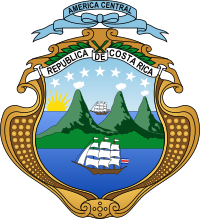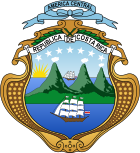Legislative Assembly of Costa Rica
Legislative Assembly Asamblea Legislativa de la Republica de Costa Rica | |
|---|---|
 | |
| Type | |
| Type | |
| Leadership | |
Carolina Hidalgo Herrera (PAC) | |
Vicepresident | María Inés Solis Quirós (PUSC) |
Secretary | Luis Fernando Chacón (PLN) |
| Structure | |
| Seats | 57 |
 | |
Political groups | |
| Elections | |
| Proportional Representation with seats distributed according to the provinces' population | |
Last election | February 4, 2018 |
Next election | February 6, 2022 |
| Meeting place | |
 | |
| San Jose, Costa Rica | |
| Website | |
| http://www.asamblea.go.cr/ | |
 |
|---|
|
|
The Legislative Assembly (Template:Lang-es) is the unicameral legislative branch of the government of Costa Rica. The national congress building is located in the city capital, San José, specifically in El Carmen District in San José Canton.
Composition
The Legislative Assembly is composed of 57 deputies (diputados), who are elected by direct, universal, popular vote on a proportional representation basis, by provinces, for four-year terms. A 1949 constitutional amendment prevents deputies from serving for two successive terms; however, a deputy may run again for an Assembly seat after sitting out a term.
| Province | Number of seats | Population |
|---|---|---|
| 19 | 1,404,242 | |
| 11 | 885,571 | |
| 7 | 490,303 | |
| 6 | 433,677 | |
| 5 | 410,929 | |
| 5 | 386,862 | |
| 4 | 354,154 |
Directory
Following the 2014 legislative election, the Citizens' Action Party was able to form an alliance with Broad Front and the Social Christian Unity Party. The three parties together amounted to thirty seats, thus giving them control of the legislature.[1] The alliance broke a year later, with PAC only receiving the support of Broad Front and PUSC joinning an opposition-lead alliance headed by PLN that gave PUSC the presidency of Congress.[2] This was the first time that historical rivals PLN and PUSC join together in Parliament. The following year PLN's candidate was endorsed by the oppositional alliance whilst PAC and FA voted by their respective ballots.[2]
Parties in Legislative Assembly, 2018-2022
Political Parties in, 2014-2018  | |||||
|---|---|---|---|---|---|
| Party Flag | Party Name (English) | Party Name (Spanish) | Abbrev. | Seats | Percentage of Assembly |
| National Liberation Party | Partido Liberación Nacional | PLN | 17 | 29.82% | |
| National Restoration Party | Partido Restauración Nacional | PRN | 14 | 24.56% | |
| Citizens' Action Party | Partido Acción Ciudadana | PAC | 10 | 17.54% | |
| Social Christian Unity Party | Partido Unidad Social Cristiana | PUSC | 9 | 15.79% | |
| National Integration Party | Partido Integración Nacional | PIN | 4 | 7.02% | |
| Social Christian Republican Party | Partido Republicano Social Cristiano | PRSC | 2 | 3.51% | |
| Broad Front | Frente Amplio | FA | 1 | 1.75% | |
Premises
The Assembly meets in the Edificio Central ("Central Building") located in the city centre of San José. Work began on this building in 1937, with the plan of having it serve as the new presidential palace. Since much of the building materials were imported from Germany and Czechoslovakia, however, the onset of the Second World War put a halt to the project. Work did not recommence until 1957, but by 1958 the legislature was installed and operating in its new premises.
History
The foundations of the Legislative Assembly date back to the establishment of various courts and congresses in New Spain.[3] The modern assembly was created in the aftermath of the Costa Rican Civil War that deposed Teodoro Picado Michalski in 1948. José Figueres Ferrer headed a ruling junta that oversaw the election of a Constituent Assembly. Between 1948 and 1949, this Constituent Assembly created the Constitution of Costa Rica which lays forth the rules governing the assembly today.[4]
During each four-year legislative session, various political parties have occupied majority, minority, and coalition banks in the assembly.
Central American Parliament
Costa Rica is the only Spanish-speaking Central American country not to return deputies to the supranational Central American Parliament.
See also
- List of Presidents of the Legislative Assembly of Costa Rica
- Politics of Costa Rica
- List of legislatures by country
References
- ^ La Nacion, "30 diputados eligieron al economista Henry Mora, del PAC, comon presidente legislativo," May 1, 2014
- ^ a b "Opposition parties maintain control over Legislative Assembly". Tico Times. May 1, 2016. Retrieved 23 August 2016.
- ^ Clotilde Obregón Quesada Clotilde (2007). Las Constituciones de Costa Rica. Tomo I. San José, Costa Rica: Editorial de la Universidad de Costa Rica. ISBN 978-9968-936-91-0.
- ^ Dieter Nohlen (2005-04-14). Elections in the Americas A Data Handbook Volume 1: North America, Central America, and the Caribbean. Oxford University Press. ISBN 978-0-19-928357-6.
External links

















